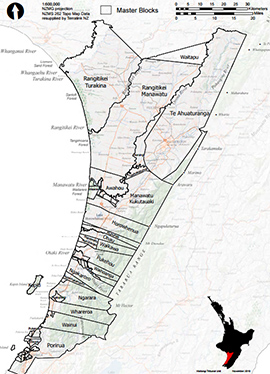Porirua ki Manawatū
Claims and geographical area

In 2008, the Waitangi Tribunal received a number of requests to inquire into Treaty claims in the Taihape, Rangitīkei, Manawatū, Horowhenua, and Kāpiti areas. Some claims in this region were already in the process of being settled, which included claims associated with Rangitāne ki Manawatū and Ngāti Toa Rangatira. After conferences with the claimants and the Crown, the Tribunal divided the region into two inquiry districts: Taihape and Porirua ki Manawatū.
Approximately 117 claims are being inquired into as part of the Porirua ki Manawatū district inquiry (Wai 2200). The claims of Ngāti Toa, Rangitāne, and Ngāti Apa are not the subject of inquiry, as those claims have been settled. Instead, the inquiry is focused on the claims of Muaūpoko, Te Ātiawa/Ngāti Awa ki Kāpiti and Ngāti Raukawa and affiliated groups, which include Ngāti Kauwhata, Ngāti Wehiwehi and the hapū of Te Reureu.
The western boundary of the Porirua ki Manawatū district extends to the Whangaehu River in the west and down the Kāpiti Coast to near the Porirua Harbour, including Mana and Kāpiti Islands. The southern boundary follows the boundary of the Whanganui-ā-Tara inquiry district from the Tasman Sea to the Tararua Ranges. The eastern boundary aligns with the eastern boundaries of the early Crown purchases and Native Land Court blocks i.e. southward from the eastern boundary of the 1864 Te Āhuatūranga purchase along the Ruahine Ranges, down the eastern boundary of the Manawatū-Kukutauaki blocks in the Tararua Ranges, to the eastern boundary of the Ngārara blocks in the south. The boundary then runs south of Ngārara down the eastern boundaries of the Whareroa and Wainui blocks. The northern boundary follows the northern boundaries of the 1849 Rangitīkei-Turakina purchase, the 1866 Rangitīkei-Manawatū purchase, and the 1864 Te Āhuatūranga purchase, from the Ruahine Ranges to the Whangaehu River.
See a map of the Porirua ki Manawatū district [PDF, 604 KB]
Major issues
The broad issues for the claims involved are:
- land loss within the rohe, including the role of the native land laws in creating a form of individualised title, and the effect of the Crown’s purchasing programme during the nineteenth century
- public works issues
- economic disadvantage and stagnation
- the effects of rating legislation and policies as applied in the inquiry district
- the Crown’s role in the ownership and management of Kāpiti and other islands
- environmental issues, including past and current examples of damage and issues around tribal authority and the Crown’s management of the environment (such as Waikanae River, Lake Horowhenua, the Hōkio Stream)
- the effect of education policies, especially the effect on te reo Māori
- native township issues
- acknowledgement of customary rights and interests across, and in some cases outside, the inquiry district
Panel members
The presiding officer of the Porirua ki Manawatū district inquiry is Chief Judge Caren Fox.
The panel also includes:
-
Emeritus Professor Sir Tāmati Reedy (to June 2017)
-
The Honourable Sir Douglas Kidd (to 26 May 2023)
Inquiry progress
From February 2014 to April 2015, the Tribunal began hearing Ngā Kōrero Tuku Iho evidence throughout the Porirua ki Manawatū inquiry district. The purpose of this forum was to hear oral history evidence from tangata whenua.
Presiding Officer Chief Judge Fox granted priority to Muaūpoko claims in October 2014.The Muaūpoko prioritised hearings took place between October and December 2015.
The Tribunal released Horowhenua: the Muaūpoko Priority Report on 30 June 2017, which broadly upheld the majority of Muaūpoko’s claims. The report found that individualisation of title to customary land by way of the Native Land Court, and the Crown purchase of the Levin township site, were significantly prejudicial to Muaūpoko. The report also identified Treaty breaches that contributed to Muaūpoko’s landlessness by the end of the twentieth century. In addition, the report found serious Treaty breaches regarding Lake Horowhenua and the Hōkio Stream.
Joint hearings were held with the Taihape Tribunal (Wai 2180) regarding technical evidence on the Rangitīkei River and its tributaries. These joint proceedings were held at the Central Trust Energy Arena in Te Papaioea/Palmerston North on 30-31 May 2017. The Tribunal heard from several technical witnesses including Dr Robert Joseph and Mr Paul Meredith (‘Ko Rangitīkei te Awa: the Rangitīkei and its tributaries cultural perspectives report’, #A190) and David Alexander (‘Rangitīkei River and its tributaries historical report’, #A187).
The Tribunal next heard Te Ātiawa/Ngāti Awa ki Kāpiti claims on a similar basis to the Muaūpoko hearings. The Te Ātiawa/Ngāti Awa ki Kāpiti phase of the inquiry had five hearings, between August 2018 and August 2019.
In May 2020, the Tribunal issued a discrete report on claims about Kārewarewa Urupā, which had been raised as an urgent matter in the hearings. The Kārewarewa Urupā Report broadly found Treaty breaches in the processes for exploratory and archaeological authorities.
In December 2022, the Tribunal released its report Waikanae, which covered the other claims heard in the Te Ātiawa/Ngāti Awa ki Kāpiti phase of the inquiry.
Hearings and events
The Tribunal is currently hearing the claims of Ngāti Raukawa and affiliated iwi/hapū.
See the Waitangi Tribunal Hearing Calendar for scheduled hearings.
For further information on the Porirua ki Manawatū inquiry please contact the Registrar at the email address below for ‘Inquiry requests’.
Document requests:
For all document requests for this inquiry, email: WT_Requests@justice.govt.nz
Inquiry requests:
For all inquiry related requests, email: WT.Registrar@justice.govt.nz
This page was last updated: